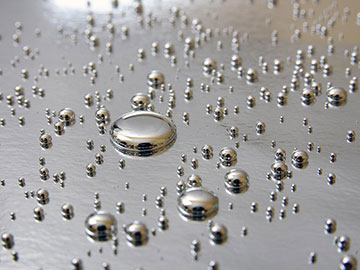![]()
Image: UNEP
According to a somewhat sensationalist November headline from the United Nations Environment Programme, 2020 is the year that the world finally bans mercury. Now that 2020 is upon us, what does this actually mean for the optics industry?
Dissecting the ban
The U.N. was referring to the Minamata Convention on Mercury—a 2013 global agreement intent on protecting human health and the environment from mercury emissions. The convention derives its name from the Japanese city of Minamata, which in the 1950s suffered terrible mercury poisoning caused by chemical pollution. The Minamata Convention entered into force in 2017, and has been ratified by 116 countries.
The 2020 deadline references the date after which the manufacture, import and export of mercury-added products outlined by the agreement are no longer allowed. However, in spite of this strong statement, this is not a blanket ban—there are quite a few exemptions to this rule, including fluorescent lamps, as long as they don’t exceed a certain mercury-content threshold.
The text also specifies that products with no feasible mercury-free alternatives available are allowed under the treaty’s terms. Moreover, each party is able to request exemptions based on the country’s needs. These exemptions remain in effect until 2025.
With these workarounds in mind, the convention’s lofty goal of banning mercury-added products as of this year becomes much more manageable. Nonetheless, the ban’s symbolism is significant. Beyond its regulatory impact, the Minamata Convention sends a clear message to industry about changing attitudes toward mercury-added products, especially for manufacturers intending to export to countries with stricter mercury regulations.
“What we’re starting to see,” says James Peterson, UVC LED product manager at Klaran, USA, “is that people are thinking about ‘what will my alternative be when this becomes more difficult?’”
Lighting and mercury

Mercury droplets. [Image: Getty Images]
In the optics community, the lighting industry has been moving toward replacing fluorescent lamps with LEDs since long before the Minamata Convention. According to Mark Lien at the Illuminating Engineering Society, USA, “that transition has had the consequential benefit of eliminating mercury.” However, Lien says, “that wasn’t the intent—the intent was energy efficiency.”
According to a report from the Interstate Mercury Education and Reduction Clearinghouse (IMERC), in 2001, some 10.71 tons of mercury was used in lamps in the United States; by 2013, that number had been cut in half to 5.24 tons. And, as Lien points out, “in 2013, the LED market penetration was single digits. Now we’re looking at at least 20%.” Ultimately, he says, “the market was already transforming, but Minamata is a positive move forward.”
One market that may feel the effects of these changing attitudes is the germicidal lighting industry, which taps into the UVC wavelength range for disinfection applications. The Minamata Convention doesn’t prohibit mercury-based fluorescent lamps for this use—it’s certainly more sustainable than, say, chemical treatment. Nonetheless, depending on the lamp technology used (low pressure versus medium pressure, for example) and the geographic region, these UV lamps can contain a wide range of mercury—from just a few milligrams all the way up to a few hundred. Thus, there’s a small but growing trend toward transitioning to non-mercury alternatives such as UVC LEDs (as well as to other mercury-free options such as phosphor-converted excimer lamps and xenon flashlamps).
UVC LEDs for disinfection

An AquiSense LED. [Image: AquiSense]
Oliver Lawal, CEO of AquiSense Technologies, estimates that germicidal lighting for water treatment is a US$1.5 billion market, and “99% of that industry uses lamps that contain mercury.” Large-scale centralized systems that use UV fluorescent lamps for water treatment, such as those in North America, Europe, Australia and China, may use more than 1 million lamps in a year, Lawal says, which adds up to a significant amount of mercury.
“Most municipalities are probably pretty good about recycling…probably.” But, based on how humans handle plastic on this planet, Lawal jokes, “almost certainly not all of those lamps are recycled.”
When you look at decentralized systems, such as for residential use, recycling of UV lamps is less regulated. So, although UVC LEDs are not yet cost-effective for large municipal systems, point-of-use systems, in the 20 gallons-per-minute (GPM) or less range, like those supplied by AquiSense and Klaran can be the smart choice—both environmentally and practically.
“Most conventional mercury lamps won't be able to offer lifetimes over a year without coming up with potentials for failure,” explains Peterson. “For intermittent disinfection, when you need it on demand, UVC LEDs are actually drastically extending lifetimes for products.” Lawal agrees, saying that “even though the light source is less efficient [than UV lamps], the system is equally as efficient. Because we use the photons more efficiently.”
Beginning of the end for mercury?
Ultimately, if UVC LEDs and other mercury-free options are to completely replace fluorescent UV lamps for germicidal applications, change will be driven by providers, who must make alternatives commercially and technologically viable, and by corporate consumers—which both Peterson and Lawal have already begun to notice. Beyond the technical benefits of UVC LEDs, says Peterson, “we're also seeing companies recognizing the need to plan for the future as mercury is becoming more and more regulated.”
[Editor’s note: This article has been updated to clarify that UV mercury lamps can vary widely in mercury content, depending on the technology, region and producer.]
